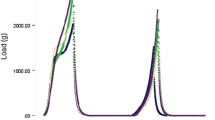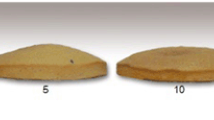Abstract
The aim of this work was to evaluate the quality characteristics of the cakes produced with zero trans interesterified shortenings containing high levels (75% and 85%) of refined olive oil (OO). A commercial cake shortening (CCS) was also used as control sample. Cake baking quality was determined by color, weight loss, volume, texture, symmetry and uniformity indices. Sensory evaluation was also conducted for shape, pore distribution, odor, off-flavor, softness, moistness and overall acceptability. Cakes produced with the fat containing 85% OO (IF2) had lighter surface color, proper symmetry and desirably curved surface. Hardness values of the cakes were increased with the increase of OO amount in the fat blends and volume of the cakes were decreased. Although total acceptability was lower than the control sample, some physical properties (pore distribution, odor, off-flavor, softness) were comparable with the control sample. The results showed that olive oil shortenings could be successfully used as a functional and nutritionally valuable substitute for commercial shortening, even in quantities up to 85%, without significant deterioration of the technological quality of cake.



Similar content being viewed by others
References
M.M. Karaoğlu, H.G. Kotancılar, Int. J. Food Sci. Technol. 44, 93–99 (2009)
J.H. Freeland-Graves, G.C. Peckham, Foundations of Food Preparation, 5th edn. (Macmillian Publishing Company, New York, 1987), pp. 308–328
E.J. Pyler, Baking Science and Technology, 3rd edn. (Sosland Publishing Company, Kansas City, 1988)
R.D. O’Brien, Fats and Oils Formulating and Processing for Applications, 3rd edn. (CRC Press, Boca Raton, 1998)
R. Micha, D. Mozaffarian, National Institutes of Health 79(3–5), 147–152 (2008). https://doi.org/10.1016/j.plefa.2008.09.008
A. Juttelstad, Food Technol. 58(1), 20–22 (2004)
Food and Agriculture Organization of the United Nations (FAO), Fats and Fatty Acids in Human Nutrition Report and Expert Consultation. Food and Nutrition Paper, 91, (2010) https://www.fao.org/3/a-i1953e.pdf. Accessed 14 March 2019
World Health Organization (WHO), Eliminating trans fats in Europe A policy brief. WHO Regional Office for Europe, 2015) https://www.euro.who.int/__data/assets/pdf_file/0010/288442/Eliminating-trans-fats-in-Europe-A-policy-brief.pdf. Accessed 14 March 2019
H. Abramovic, R. Vidrih, E. Zlatic, D. Kokalj, M. Schreiner, K. Zmitek, A. Kusar, I. Pravst, J. Food Compos. Anal. 74, 53–61 (2018)
Communiqué on the Amendment of the Communiqué on the Labeling Rules of the Turkish Food Codex for the General Labeling and Nutrition, Communiqué Number:40, Republic of Turkey Official Gazette, Issue:26622 (2007)
O. Dağlıoğlu, M. Taşan, B. Tunçel, Turk. J. Chem. 26, 705–710 (2002)
E.K. Richter, K.A. Shawish, M.R.L. Scheeder, P. Colombani, J. Food Compos. Anal. 22(5), 479–484 (2009)
D. Mozaffarian, M.B. Katan, A. Ascherio, M.J. Stampfer, W.C. Willett, N. Engl. J. Med. 354(15), 1601–1613 (2006)
N.A. Idris, N.L.H.M. Dian, Asia Pac. J. Clin. Nutr. 14, 396–401 (2005)
S.P.J.N. Senanayake, F. Shahidi, in Bailey’s Industrial Oil and Fat Products, ed. by F. Shahidi (Wiley, Hoboken, 2005), pp. 555–584
M. Alpaslan, A. Karaali, Food Chem. 61(3), 301–305 (1998)
D. Kaçar, H. Erinç, D. Sivri Özay, Acta Aliment. 47, 2,154–161. (2018). https://doi.org/10.1556/066.2018.47.2.3
Official Methods and Recommended Practices of the American Oil Chemists’ Society (AOCS), (The Association [AOCS], Champaign, IL, 1989)
Official Methods and Recommended Practices of the American Oil Chemists’ Society (AOCS), 4th edn. (The Association [AOCS], Champaign, IL, 2003)
Standard Methods for Analysis of Oils, Fats and Derivatives, International Union of Pure and Applied Chemistry (IUPAC), 7th edn., IUPAC Method 2.301.) (Blackwell Scientific Publications, Oxford, 1987)
F. Shaidi, U.N. Wanasundara, in Food Lipids-Chemistry, Nutrition, and Biotechnology, ed. by C.C. Akoh, D.B. Min (Marcel Dekker Inc, New York, 2002), pp. 465–487
American Assosication of Cereal Chemists, Approved Methods of the AACC, 8th edn. (AACC, St. Paul, 1990)
American Association of Cereal Chemists (AACC), Approved Methods of Analysis, 10th edn. (AACC, St. Paul, 2000)
M. Criado, E. Hernandez-Martin, A. Lopez-Hernandez, C. Otero, Eur. J. Lipid. Sci. Technol. 110(8), 714–724 (2008)
V. Gavriilidou, D. Boskou, Int. J. Food Sci. Technol. 26, 451–456 (1991)
A. Matsakidou, G. Blekas, A. Paraskevopoulou, LWT Food Sci. Technol. 43, 949–957 (2010)
M.H.F. Felisberto, A.L. Wahanik, C.R. Gomes-Ruffi, M.T.P.S. Clerici, Y.K. Chang, C.Y. Steel, LWT Food Sci. Technol. 63(2), 1049–1055 (2015)
Acknowledgements
This project was supported by The Scientific and Technological Research Council of Turkey (Tübitak TOVAG 108 O 586).
Author information
Authors and Affiliations
Corresponding author
Ethics declarations
Conflict of interest
The authors declare that they have no conflict of interest.
Additional information
Publisher's Note
Springer Nature remains neutral with regard to jurisdictional claims in published maps and institutional affiliations.
Rights and permissions
About this article
Cite this article
Kaçar, D., Sivri Özay, D. Olive oil shortenings as an alternative to commercial shortenings in cake production: physical and sensory properties. Food Measure 13, 2846–2852 (2019). https://doi.org/10.1007/s11694-019-00205-5
Received:
Accepted:
Published:
Issue Date:
DOI: https://doi.org/10.1007/s11694-019-00205-5




